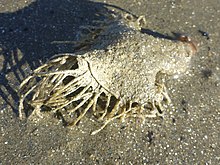Pista pacifica
Appearance
| Pista pacifica | |
|---|---|

| |
| Anterior portion of the body of Pista pacifica | |

| |
| Entrance to the burrow of Pista pacifica | |
| Scientific classification | |
| Domain: | Eukaryota |
| Kingdom: | Animalia |
| Phylum: | Annelida |
| Clade: | Pleistoannelida |
| Clade: | Sedentaria |
| Order: | Terebellida |
| Family: | Terebellidae |
| Genus: | Pista |
| Species: | P. pacifica
|
| Binomial name | |
| Pista pacifica Berkeley & Berkeley, 1942
| |
Pista pacifica is a species of polychaete worm in the family Terebellidae native to the coastal regions of the northeastern Pacific Ocean, from British Columbia to Southern California.[1][2] It creates vertical tubes in intertidal mud or sand[2] that can be more than two feet deep.[3] The tubes extend above the substrate, terminating in overhangs bearing many marginal tendrils.[2] The worms themselves can grow up to 37 cm long,[2] and, like all members of the family Terebellidae, they are particle feeders that use their tentacles to forage for organic detritus around their burrows.[2] The scale worm Halosydna brevisetosa may reside commensally in their tubes.[4]
References
[edit]- ^ Fauchald, Kristian. "WoRMS - World Register of Marine Species - Pista pacifica Berkeley & Berkeley, 1942". www.marinespecies.org. Flanders Marine Institute. Retrieved 26 November 2022.
- ^ a b c d e Morris, Robert H. (1980). Intertidal invertebrates of California (1 ed.). Stanford, Calif.: Stanford University Press. p. 471. ISBN 0-8047-1045-7.
- ^ Ueda, Ken-ichi (5 June 2019). "Pista pacifica from Half Moon Bay, CA 94019, USA on June 05, 2019 at 07:46 AM". iNaturalist. Retrieved 26 November 2022.
- ^ Carlton, James T. (2007). The Light and Smith manual : intertidal invertebrates from central California to Oregon (Fourth, completely revised and expanded ed.). Berkeley, California: University of California Press. p. 399. ISBN 0-520-23939-3.
This article needs additional or more specific categories. (November 2022) |
